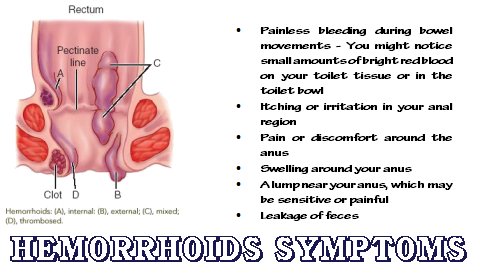SYMPTOMS OF HEMORRHOIDS

Signs and symptoms of hemorrhoids may include:
- Painless bleeding during bowel movements — you might notice small amounts of bright red blood on your toilet tissue or in the toilet bowl Itching or irritation in your anal region
- Pain or discomfort
- Swelling around your anus
- A lump near your anus, which may be sensitive or painful
- Leakage of feces
Hemorrhoid symptoms usually depend on the location. Internal hemorrhoids lie inside the rectum. You usually can't see or feel these hemorrhoids, and they usually don't cause discomfort.
But straining or irritation when passing stool can damage a hemorrhoid's delicate surface and cause it to bleed. Occasionally, straining can push an internal hemorrhoid through the anal opening. This is known as a protruding or prolapsed hemorrhoid and can cause pain and irritation.
External hemorrhoids are under the skin around your anus. When irritated, external hemorrhoids can itch or bleed. Sometimes blood may pool in an external hemorrhoid and form a clot (thrombus), resulting in severe pain, swelling and inflammation.
WHEN TO SEE A DOCTOR
Bleeding during bowel movements is the most common sign of hemorrhoids. But rectal bleeding can occur with other diseases, including colorectal cancer and anal cancer. Don't assume that bleeding is coming from hemorrhoids without consulting a doctor.
Your doctor can do a physical examination and perform other tests to diagnose hemorrhoids and rule out more-serious conditions or diseases. Also consider seeking medical advice if your hemorrhoids cause pain, bleed frequently or excessively, or don't improve with home remedies.
If your hemorrhoid symptoms began along with a marked change in bowel habits or if you're passing black, tarry or maroon stools, blood clots, or blood mixed in with the stool, consult your doctor immediately. These types of stools can signal more extensive bleeding elsewhere in your digestive tract.
Seek emergency care if you experience large amounts of rectal bleeding, lightheartedness, dizziness or faintness.
Make an Appointment